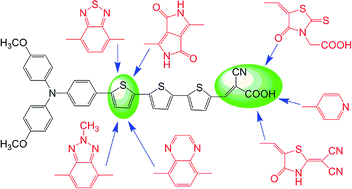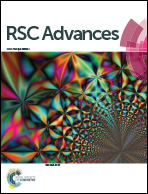Design of D–A–π–A organic dyes with different acceptor and auxiliary acceptor for highly efficient dye-sensitized solar cells: a computational study†
Abstract
D–A–π–A dyes have exhibited several excellent advantages including optimized energy levels, and distinct improvement of photovoltaic performance and stability. By modulating the auxiliary acceptor and acceptor unit, the efficiency of D–A–π–A dye based dye-sensitized solar cells can be further improved. Based on density functional theory methods, sixteen dimethoxyl-substituted triphenylamine based D–A–π–A dyes composed of different acceptor and auxiliary acceptor groups were designed, meanwhile for reference four homologous D–π–A dyes were also compared in this work. The properties of all the dyes, including intramolecular charge transfer, light harvesting efficiency, kinetics of electron injection, and vertical dipole moment, have been investigated theoretically to identify the dyes which would produce high efficiency. Then the interaction between the selected dyes and the electron acceptor in the electrolyte was discussed to reveal the interfacial charge recombination process. In comparison with other dyes, TNA4 displays outstanding performance due to its key parameters to achieve a balance between competing factors. Compared with cyanoacrylic acid, 2-(1,1-dicyanomethylene) rhodanine group can serve as an excellent acceptor for future DSSCs applications.


 Please wait while we load your content...
Please wait while we load your content...